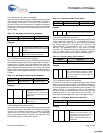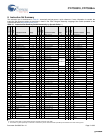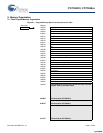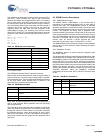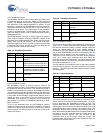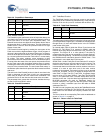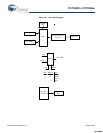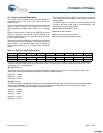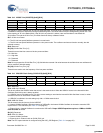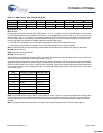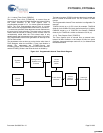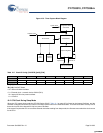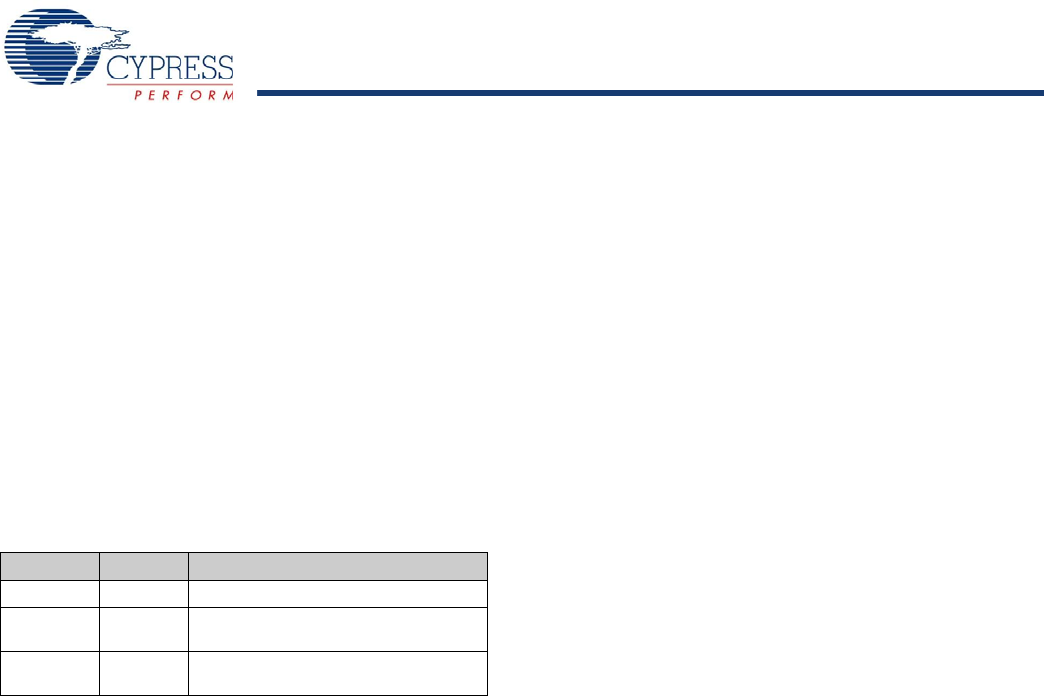
CY7C63310, CY7C638xx
Document 38-08035 Rev. *K Page 19 of 83
9.5.8 Checksum Function
The Checksum function calculates a 16-bit checksum over a
user specifiable number of blocks, within a single Flash macro
(Bank) starting from block zero. The BLOCKID parameter is
used to pass in the number of blocks to calculate the checksum
over. A BLOCKID value of 1 calculates the checksum of only
block 0, while a BLOCKID value of 0 calculates the checksum of
all 256 user blocks. The 16-bit checksum is returned in KEY1 and
KEY2. The parameter KEY1 holds the lower eight bits of the
checksum and the parameter KEY2 holds the upper eight bits of
the checksum.
The checksum algorithm executes the following sequence of
three instructions over the number of blocks times 64 to be
checksummed.
romx
add [KEY1], A
adc [KEY2], 0
10. Clocking
The enCoRe II has two internal oscillators, the Internal 24 MHz
Oscillator and the 32 kHz Low power Oscillator.
The Internal 24 MHz Oscillator is designed such that it may be
trimmed to an output frequency of 24 MHz over temperature and
voltage variation. With the presence of USB traffic, the Internal
24 MHz Oscillator may be set to precisely tune to the USB timing
requirements (24 MHz ± 1.5%). Without USB traffic, the Internal
24 MHz Oscillator accuracy is 24 MHz ± 5% (between 0°–70°C).
No external components are required to achieve this level of
accuracy.
The internal low speed oscillator of nominally 32 kHz provides a
slow clock source for the enCoRe II in suspend mode, particu-
larly to generate a periodic wakeup interrupt and also to provide
a clock to sequential logic during power up and power down
events when the main clock is stopped. In addition, this oscillator
can also be used as a clocking source for the Interval Timer clock
(ITMRCLK) and Capture Timer clock (TCAPCLK). The 32 kHz
Low power Oscillator can operate in low power mode or can
provide a more accurate clock in normal mode. The Internal
32 kHz Low power Oscillator accuracy ranges (between
0°–70° C) follow:
■
5V Normal mode: –8% to + 16%
■
5V LP mode: +12% to + 48%
When using the 32 kHz oscillator, the PITMRL/H registers must
be read until 2 consecutive readings match before the result is
considered valid. The following firmware example assumes the
developer is interested in the lower byte of the PIT.
Read_PIT_counter:
mov A, reg[PITMRL]
mov [57h], A
mov A, reg[PITMRL]
mov [58h], A
mov [59h], A
mov A, reg[PITMRL]
mov [60h], A
;;;Start comparison
mov A, [60h]
mov X, [59h]
sub A, [59h]
jz done
mov A, [59h]
mov X, [58h]
sub A, [58h]
jz done
mov X, [57h]
;;;correct data is in memory location 57h
done:
mov [57h], X
ret
Table 9-12. Checksum Parameters
Name Address Description
KEY1 0,F8h 3Ah
KEY2 0,F9h Stack Pointer value when SSC is
executed.
BLOCKID 0,FAh Number of Flash blocks to calculate
checksum on.
[+] Feedback [+] Feedback



